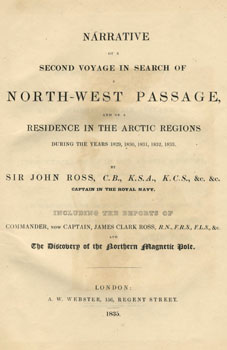
Robert Abram Bartlett, Arctic mariner, explorer, ice captain, scientist (born 15 August 1875 in Brigus, NL; died 28 April 1946 in New York City, NY). During a career that spanned a half-century, Robert Abram Bartlett undertook more than 40 voyages into northern waters and became one of the most experienced ice captains to ever operate in the Arctic. Bartlett participated in several famous Arctic ventures, including the Canadian Arctic Expedition (1913–1918), on which he served as captain of the doomed flagship Karluk. Over the course of his career he survived two shipwrecks , saving the lives of his shipmates as a result, and made significant contributions to the scientific and cartographic understanding of the Arctic.
Early Life and North Pole Expeditions
Robert Bartlett was born in Brigus, Newfoundland in 1875, to a family with a rich seafaring heritage. He grew up fishing and sealing off the Labrador coast with his father, and quickly learned it was, in his words, in his “blood to keep to the sea and to push out into the wild spaces of the earth.” As a teenager he found employment on merchant vessels and gained enough experience to take the examinations necessary to become a captain, which he successfully passed in Halifax in 1898. Rather than immediately take command his own ship, Bartlett instead chose to serve as first mate on board Windward, American explorer Robert Peary’s support vessel, on his first serious effort to reach the North Pole between 1898 and 1902. Bartlett spent the next four years locked in the ice off Ellesmere Island, where he learned how to navigate and live in the harsh Arctic environment from the expedition’s Inuit guides and hunters, and developed a close friendship with Peary.
Although the expedition ended in failure, as Bartlett later recalled, he was now “committed to Arctic work.” He chose to accompany Peary on his second attempt to reach the Pole in 1905–1906 as commander of the steel-hulled Roosevelt. Peary again failed, and the voyage back to New York tested Bartlett’s seamanship and leadership with severe storms, heavy ice, fire, damaged propellers and a broken rudder. Despite this experience, Bartlett volunteered to captain Roosevelt on Peary’s final effort to reach the Pole in 1908–1909. He played a pivotal role in the march northwards, breaking trail over the harsh Arctic ice to within 240 km of the Pole. While he did not go to the Pole with Peary, Bartlett led the expedition to 87°48' N latitude, earning him the Hubbard Medal on 31 March 1909, the highest award of the National Geographic Society.
The Canadian Arctic Expedition and the Karluk
After Robert Peary’s voyages, Robert Bartlett longed to the return to the Arctic. "It's all right while you're exploring,” the captain asserted. “You get used to rotten meat, frozen fingers, lice and dirt. The hard times come when you get back." In 1913, Bartlett accepted Vilhjalmur Stefansson’s invitation to command the Canadian Arctic Expedition’s flagship, Karluk, although he expressed intense reservations about the vessel’s suitability for service in the winter ice. On 13 August 1913, his fears were realized when thick ice entrapped the vessel about 322 km beyond Point Barrow, Alaska. Karluk drifted through the ice for five months until it sank north of Siberia on 11 January 1914, leaving its crew stranded. Under Bartlett’s leadership, the group soon moved to nearby Wrangel Island, where austere conditions and hunger started to take their toll. To save his crew, Bartlett and an Iñupiat hunter, Kataktovik, undertook a dangerous march 320 km across the ice to the Russian coastline, and another 650 km to Alaska, where they dispatched a rescue mission in September 1914. Despite Bartlett’s efforts, 11 crewmembers perished.
The public and press hailed Bartlett as a hero; however, a British Admiralty commission criticized him for taking Karluk so deeply into the ice. Survivors of the ordeal came to the Bartlett’s defence. "There was for me only one real hero,” recalled expedition staff scientist and crewmember William Laird McKinlay. “Bob Bartlett. Honest, fearless, reliable, loyal, everything a man should be."
Life with Effie M. Morrisey
Robert Bartlett successfully applied for US citizenship shortly after his return from the Arctic in the hopes he could attract American support for more northern voyages. In 1917, Bartlett rescued Donald Baxter MacMillan’s Crocker Land Expedition after its failed attempt to find new territory above Ellesmere Island. Later, he served in the US army and navy during the First World War, assisting with the transportation of troops and supplies between US ports.
After the war, Bartlett occasionally advised the US Navy on Arctic issues, but struggled to attain funding for another Arctic expedition. With support from an American friend, however, Bartlett bought the schooner Effie M. Morrissey. From July 1926 until the beginning of the Second World War, the captain and his beloved “little Morrissey” made 14 trips to the Arctic, exploring the northeast and northwest coasts of Greenland, and remote parts of the Canadian Arctic. With support from the Smithsonian Institute, the American Museum of Natural History, and the New York Botanical Garden, Bartlett’s voyages conducted oceanographic, atmospheric and other scientific research, supported several archaeological surveys, and mapped and charted various parts of the Arctic Ocean — incredible accomplishments for a man with little formal scientific training.
During the Second World War, Bartlett and “little Morrissey” worked for the US military, resupplying bases in Greenland and the Canadian Arctic. After hostilities ended, Bartlett contemplated further Arctic voyages, but contracted tuberculosis and passed away in New York at the age of 70.

 Share on Facebook
Share on Facebook Share on X
Share on X Share by Email
Share by Email Share on Google Classroom
Share on Google Classroom


